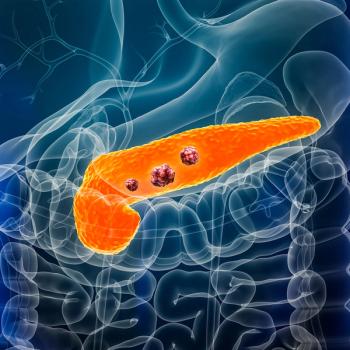
Radium-223 Continues to Benefit Patients With Castration Resistant Prostate Cancer
Expert Michael Morris, MD, discusses the current and future role of radium-223 dichloride in treatment for patients with metastatic castration-resistant prostate cancer (mCRPC).
Michael J. Morris, MD
For patients with metastatic castration-resistant prostate cancer (mCRPC), the radiopharmaceutical radium-223 dichloride (Xofigo) has proven to be an efficacious bone-targeted agent. Its optimal role in these patients will continue to evolve, explains Michael J. Morris, MD, as combination studies read out in the next couple of years.
For instance, the safety and efficacy of radium-223 is being explored alone or in combination with enzalutamide (Xtandi) or abiraterone acetate (Zytiga) in patients with mCRPC in a phase IIa study (NCT02034552). The primary endpoint of the open-label randomized trial is patient bone scan response.
During the recent OncLive State of the Science Summit on Genitourinary Cancers, Morris discussed the use of bone-seeking radiopharmaceuticals in prostate cancer, with a specific focus on radium-223.
In an interview at the meeting, Morris, an associate professor of Medicine at Memorial Sloan Kettering Cancer, shared his expertise on radium-223’s current role in patients with mCRPC and how he anticipates that role will evolve going forward.
OncLive: What was the focus of your lecture at this meeting?
Morris: [We looked at] some of the new approaches in terms of combinations with other agents that are tumor directed, as well as the newer technologies in using radio nucleotides to target prostate cancer itself. It’s a pretty exciting field right now. There are a lot of changes happening, and I summarized the field and moving forward, what questions remain open, and what new trials are beginning.
Surely, radium-223 was a major focus of this discussion?
A significant component is radium-223. That is the only FDA-approved therapy in terms of a radiopharmaceutical that is bone directed with an alpha emitter. I’m hoping, within the next couple of years, we will see some tumor-directed radiopharmaceuticals—some of which are alpha emitters and some of which are beta emitters.
Ultimately, we want to be able to target multiple compartments. The bone compartment and the tumor compartment are not necessarily the same. There are advantages to how you might be able to integrate directed therapy at the cancer, as well as the primary metastatic component that it occupies.
What have you found that sets radium-223 apart from other therapies?
It’s a first-in-class agent, so that sets it apart as it’s a stand-alone drug with really nothing else like it. This really gives it a level of interest that is unique.
Secondly, its mechanism of action lends a very low toxicity profile, unlike chemotherapy or other radiopharmaceuticals. It really does have very little in the way of hematologic toxicity. It prolongs life and delays skeletal-related events, so it has a huge opportunity to be combined with other agents.
It’s being combined right now in clinical trials with androgen receptor (AR)—directed agents. We have some early studies that are going to move into phase III of combinations with chemotherapy, and whether or not it could be combined with tumor-directed radiotherapy is an interesting question that we have yet to determine.
It’s uniquely suited for many patients with prostate cancer because it prolongs life with a minimum of side effects and it can overlap with other drugs. Right now, you can’t combine it with chemotherapy by its label, but we do have safety data on that. We are advancing to phase III and, hopefully in a few years, we will be able to coordinate these 2 therapies and demonstrate a survival prolongation.
What is the logic behind the thinking that radium-223/chemotherapy or radium-223/AR-directed agents would have efficacy?
If you think of radium-223 as a bone-targeted agent, it is very effective at delivering a high degree of energy in a very narrow actual physical, penetrative distance in the bone. There is tumor that’s located deeper within the bone that presumably is outside the direct reach of an alpha particle. That doesn’t mean there can’t be indirect effects that impact a tumor that’s deeper within the bone. However, there is also a circulating tumor cell (CTC) component that’s not bone based, even in patients with bone-only disease by scans.
Then, there are patients who have nodal or visceral disease for whom radium-223 can’t reach. If you have a soft tissue component that’s visualized or not visualized but is present, and if you have tumor within the bone that is beyond the reach of an alpha particle, then it does make sense to apply some tumor-directed therapy. This is in addition to the bone-directed therapy to reach those compartments of disease that otherwise would be beyond the penetrative distance of an alpha particle.
AR-directed therapy could help with visceral disease, a CTC component, or the boney disease that isn’t otherwise going to be hit by the alpha particle—in addition to the compartment contamination that the bone-seeking radiopharmaceutical provides.
Will radium-223, or other next-generation radiopharmaceuticals, always have a role in this disease?
Part of that is philosophical. Tumor-directed therapy can be very effective but, if you think of it in environmental terms, one of the challenges of it is that it’s the equivalent of trying to kill a billion mosquitos. You can try to do that or you can try to drain the swamp. Bone-directed therapy has the latter approach and tumor-directed therapy has the former approach.
One approach will probably never be perfect, and it’s some blend of those of changing the whole environment plus targeting any residual disease that will ultimately render you to a tumor burden of both. That’s what our hope would be. Will 1 therapy be able to do that to the exclusivity of another? I doubt it. You are going to need a multi-pronged approach.
You were chair of this State of the Science Summit. What is the significance of having this type of event?
It is really an opportunity to summarize the whole field, especially for community oncologists or for academic oncologists who may not have such an interest in genitourinary oncology to summarize the state of play in the field. [It is valuable to discuss] where we stand in terms of data that have been analyzed and presented over the last few years, and how that might forecast for tomorrow’s trials and where the field might be going.
Sometimes at meetings, it is very hard to have an intimate discussion about this. The meetings are very large and you are just listening to 1 presentation after another. This affords an atmosphere of interaction and there is a group to coordinate with the audience, and with each other, to focus on a few key concepts and more detail than you can at a larger meeting.


















































































